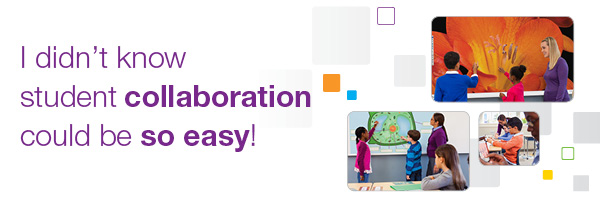Get multiple students working interactively using Mimio.

The beginning of the school year is a great time to make fresh starts and implement new ideas to help students learn in the classroom. While learning styles vary for each student, we know that getting kids involved is instrumental in the learning process. Integrating methods that engage students through interactivity and collaboration with their peers not only 'hooks' them into the lesson being presented, but also enriches their learning experience.
Mimio technology can make classroom collaboration effortless. Using an interactive whiteboard product such as a touch display, interactive projector, or even your own mobile devices with the MimioMobile™ app, multiple students can work together to complete activities. There are lots of ways to get students to interact and work together using the activities and lessons you already have. Even if you lack technology in your classroom, you can easily adapt the following ideas using a multitude of other tools, such as mini-whiteboards, butcher paper, or classroom discussion.
For example:
- Front-of-the-classroom problem solving. If you want to assign a set of algebra problems, you can use a touch display that allows as many as six students to work together at the same time, like the MimioDisplay™ touch display. Choose some students to come to the front of the classroom. Tell them that they will work simultaneously on the touch display, but each of them must solve a different problem from the problem set. Then have the problem solvers take turns explaining their strategy to the rest of the class. You can print or save their digital work as a MimioStudio™ file, which can help other students who are struggling or absent from class.
- Designing experiments in teams. In science lab, you break students into groups of two and ask them to design an experiment to test what impacts the time of a swinging pendulum. After a brainstorming session, you want each team to share with the rest of the class their ideas on variables, controls, and their plan of action for the experiment. If you are using an interactive projector like the MimioProjector™ interactive projector, you can have up to two writing inputs at the board at the same time. Teacher input and discussion with the rest of the class can then follow.
- Sentence diagramming – at the board or in the class. In language arts, you import a PDF into MimioStudio software from a textbook series that contains sentences for diagramming. You then ask three students to come to the board to use a touch display like the MimioDisplay device. You assign a different sentence to each student for simultaneous diagramming. If you are using MimioMobile-enabled mobile devices in the classroom, you can give individual control to any student with a device, to complete the task right from his or her seat.
- Pictionary-type learning. You are preparing your students for an upcoming social studies test on the Civil War, using a game based upon Pictionary. You divide your class into two teams for a review of important concepts and terms. You ask one student from each team to come to the front and use a stylus pen with an interactive projector like the MimioProjector device. You randomly draw a card with one of the Civil War concepts or terms on it, and show it only to the two students. They immediately turn to the board and begin drawing picture clues for their teams to begin guessing. The winning team is the one that guesses the concept or term first. That team must then describe its importance and how it relates to the Civil War.
Opportunities for student collaboration can be shaped in a number of ways, depending on your learning goals. As you develop lessons, build in options for students to challenge themselves and have meaningful experiences and interactions. Empower students to develop and use critical thinking skills to solve problems, communicate with others, and work as part of a team. These are some of the fundamental skills that students will need to become productive citizens of the 21st century.
If you find these ideas helpful, you may enjoy downloading Collaborate to the Core, an excellent guide to a variety of techniques and suggestions for creating collaborative learning in your classrooms. Download Now. >>





